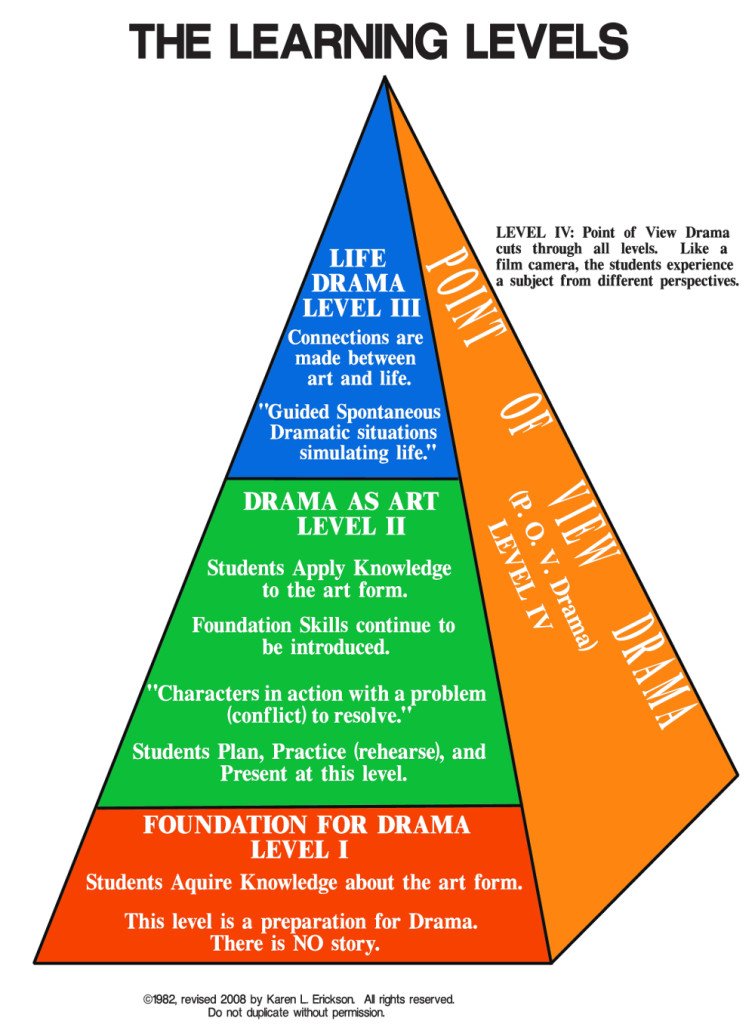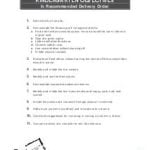Drama & Character Education
Building character is a life long process. The formation of good character begins when people are very young. There are many human qualities that make character: honesty responsibility, resourcefulness, etc. Many of these qualities can be taught through a well-designed drama program. How does it work?
- FIRST: drama is a study of character. As an audience or reviewer of drama, one can study human behavior because drama centers on human beings or personified characters with human traits. Through drama, we view how various personalities deal with conflict and reveal the inner self. Comparisons to one’s own life are inevitable.
- SECOND: when actively participating in a drama, people experience how characters create, respond to, and deal with conflict, tension, and heightened emotions. Actors walk for a time in the shoes of another human and experience the world from a different point of view.
- THIRD: teamwork is a necessary component in creating a drama. Drama takes skills in group collaboration, discussion and problem solving to create a finished product. Through participation in the dramatic process, a person’s character is revealed as they determine who will play which role, apply creative solutions and suggest ideas that may or may not be accepted by the team/ensemble. It is through this planning process that a teacher can shape leadership, responsibility, honesty, and compassion.
"Good character is defined by what you do when no one is watching."
Read these thoughts to get us started:

Building personal character through drama is easy with many of its interactive processes: planning, rehearsing, devising, evaluating, and critiquing others. During the acting process, actors must interpret, analyze, discuss, and imitate the character traits of the roles they play in a given story. Additionally, other skills such as making and keeping commitments, improving audience behaviors which impact the specific behaviors of others, listening, and responding with empathy are key to the art form. These skills apply to areas beyond drama and serve to promote positive character development. You will find that drama tools will equip the students with valuable life skills.
Our chart below outlines drama's use in building personal character. The chart lists the dynamic traits that directly influence the development and presentation of dramatic work. These traits have been divided into two categories:
- INTERPERSONAL: Interpersonal traits directly impact communication with others such as a team or partner.
- INTRAPERSONAL: Intrapersonal traits impact an actor’s self visualization, awareness, and definition.
| Character Traits | Practices | Drama Connections |
|---|---|---|
| ADAPTABILITY Interpersonal | Adapting to changes in people and circumstances. |
|
| COMPASSION Interpersonal | Showing kindness and concern for others. |
|
| CONTEMPLATION Intrapersonal | Thinking things through. Reasoning, solving, analyzing. Thinking creatively and critically. Brainstorming. Visualizing the end goal. |
|
| COURAGE Intrapersonal | Taking risks. Facing problems squarely. |
|
| HONESTY Interpersonal | Acting truthfully. Refusing to take unfair advantage of others. |
|
| INITIATIVE Intrapersonal | Taking responsible action without prompting. Demonstrating leadership. |
|
| LOYALTY Interpersonal | Making a commitment. Keeping a commitment. |
|
| OPTIMISM Intrapersonal | Being positive. |
|
| PERSEVERANCE Intrapersonal | Working toward a goal even in the face of difficulties. Using conflict resolution strategies. |
|
| RESPECT Interpersonal | Showing consideration and regard for self and others. |
|
| RESPONSIBILITY Intrapersonal | Being accountable for personal actions. |
|
| TRUSTWORTHINESS Interpersonal | Letting actions communicate reliability and believability. |
|
You can download a PDF of the table here![]() .
.
We designed our lessons to assist building personal character through drama. We've made it simple for you to implement in your class: JOIN today and see!
Character Education and Building Self Esteem
Drama and self esteem are natural partners. All of the fine arts, including drama/theater, give people insight into themselves. Participants in the arts gain insight about their potential and function in the greater world.  Drama/theater specifically uses tools (body, mind, voice) that are one with the user. For younger students, the use of play in the classroom gives students immediate success because they have spent their early life learning through play. They are experts. Older students and adults need to revisit play and become comfortable with that mode of learning. Exploring self, defining self, and coming to understand one’s interrelationship to the natural and human world is what drama/theater and self esteem are both about.
Drama/theater specifically uses tools (body, mind, voice) that are one with the user. For younger students, the use of play in the classroom gives students immediate success because they have spent their early life learning through play. They are experts. Older students and adults need to revisit play and become comfortable with that mode of learning. Exploring self, defining self, and coming to understand one’s interrelationship to the natural and human world is what drama/theater and self esteem are both about.
Through drama students achieve:
- + Pride and security
- + Self knowledge
- + Trust and belonging
- + Control, partnership, and mission
- + Competence
- Drama/theater is a high risk activity (sometimes for both students and teachers). When a safe classroom is created* and students are successful their sense of pride and sense of security with the teacher and peers soars. (*See the Classroom Management Tips for Drama)
- Drama/theater impacts and individualizes self-knowledge. Children who need to be "perfect" will learn not to expect perfection all the time in drama because the tasks rely on multiple intelligences. Everyone will shine in some aspects of the program and struggle with others. The Debrief and Learn sections of each lesson in this book are designed to encourage students to discuss their strengths and weaknesses.
- Students learn to trust others and develop a sense of belonging in a group. In this drama program teachers are encouraged to reassign groups each new lesson or unit. Drama is a strong motivator leading to cooperation because cooperation is the only road to a completed activity they can share. In a safe classroom, all students love to have completed dramas to share!!
- The drama program sets realistic achievable goals that give students a sense of self-management and partnership in their work. Students should learn concepts, skills, and terms presented to them in each lesson at one level before moving to a higher level. Teachers should discuss with students the outcomes for the session during the Starters section of each lesson. The teacher should clearly state what is to be learned. If students don't achieve what is expected, the Debrief and Learn activity provides a place for the teacher to ask the students for a better approach, strategy, or method of accomplishing the goal.
- When the drama program scope and sequence is adhered to, students gain a sense of competence. By becoming aware of their strengths and weaknesses in lower grades, they are able to choose the roles and jobs in more complex upper grade drama activities which allow them to take the next steps toward reaching their potential.
Character Education and Conflict Resolution
The essence of drama is conflict and tension. It is the conflict in drama that propels the story to its resolution. Because drama is a heightened and controlled expression of life, relationships, and emotions, it can be a safe place for people of all ages to work through frustration, anger, and violent tendencies of character.
Good drama leaders begin by establishing a safe, non-judgmental environment, then engage students in discussing the causes and effects of violence in the context of story. They can reshape the violent moment into alternate choices, and they can design dramatic moments, distanced from the violence, to let participants gain new perspective on events, attitudes, and actions.
“Conflict is no stranger to theatre; drama is built on the premise of conflict. What could be a more natural resource with which to explore conflict resolution?” - Patricia Sternberg, Theatre for Conflict Resolution
Three major areas through which drama can impact violent behavior are:
- Developing personal character traits
- Learning to handle conflict
- Learning to like and care for the self
The chart that follows (also available as a PDF file) offers some ideas on how and why to integrate drama and conflict resolution:
| Use DRAMA for: | What can be included in Character Education Curriculum? | Kindergarten Drama Activities from Erickson Drama/Learning Program: | Concepts K-8 to Integrate Drama: | |
|---|---|---|---|---|
| DEVELOPING PERSONAL CHARACTER TRAITS | Practicing Empathy and Respect | Identify emotions Identify actions that cause emotions Analyzing consequences Alternative courses of action | Finding Myself in Drama Henny Penny The Three Billy Goats Gruff | Group process skills Character development from cross cultural perspectives Problem solving Imitating emotions Praising others and self |
| Studying the Lives of Real People | Great leaders Historical choices Current conditions related to past choices | Biographies | Adding details Types of conflict Solving conflict Listening |
|
| LEARNING TO HANDLE CONFLICT | Conflict Structure | Types of conflict Beginning, middle, and end of conflict Stereotyping/ labeling Alternative courses of actions Analyzing conflict in literature/media Causes of conflict | The Three Billy Goats Gruff Caveman Seeds & Plants: Carrot Seed | Types of conflict Solving conflict Beginning, middle, end of story Imitation Critical analysis Action/Reaction Character stereotypes Character analysis |
| Predicting Consequences | Analyzing events Analyzing consequences | The Snowman Humpty Dumpty Charlie Lesson Prop Box Seeds Grow/Greedy Little Fish Seeds & Plants: Empty Pot | Action/Reaction Characterization Plot details Dramatic/story structure Comparing story to everyday life |
|
| Negotiation Skills | Negotiation strategies Group process skills Listening Brainstorming | Finding Myself in Drama Working with Space Elves and the Shoemaker Caps for Sale | Concentration Listening Communication Collaboration Personal space Body movement Group process skills Negotiation strategies |
|
| Emotion Management | Identify emotions & body response Anger management Making choices Identifying actions that cause emotions | Emotions Lesson Caveman Introducing 5 Senses Magic Carpet The Three Billy Goats Gruff I Woke Up this Morning | 4 basic emotions 5 senses Use of voice and Space Action/Reaction (Cause/Effect) |
|
| SELF-ESTEEM & SELF-CARE | Learning to Like and Care for Self | Building pride & self knowledge Create trust & belonging Control learning & self expression Build competence | Mirror Caveman Seeds & Plants: Carrot Seed | Risk taking There is more than one right answer in drama Focus on process not perfection Praising others and self |
Next section: Tips for Kindergarten (& pre-K) Drama -->
Pre-K and Kindergarten Curriculum



Purchase or download individual lessons below This year-long planning guide maps a year of drama teaching. We put these lessons in a recommended delivery order below, but you may revise, ...


